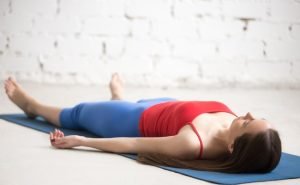Yoga Nidra, also known as Yogic Sleep is an centuries old yogic practice. It’s little known to people but it’s becoming increasingly popular as both a form of meditation and a mind-body therapy.
Yoga nidra or Yogic sleep can be explained as the conscious awareness of the state of deep sleep which is referred to as prajna in Mandukya Upanishad. I won’t be wrong to term it as psychic sleep.
In simple terms you can understand it as a state of consciousness that is between sleeping and waking; somewhat one can term “going-to-sleep” stage but not exactly sleeping.
What it does is – take you to the next level. You achieve a relaxed body, a fluid mind, and better intuition.
How Yoga Nidra works?
Yoga nidra practice takes you to a state in which the body becomes completely relaxed, and the practitioner is increasingly aware of the inner world. The practitioner achieves it systematically by following a set of verbal instructions.
Unlike meditation in which the practitioner’s concentration is required to be on a single focus, Yoga Nidra has the practitioner remain in a state of light where his 5 senses (pratyahara) are withdrawn. With the 4 senses being internalised i.e. withdrawn, only the hear sense or hearing can connect with the verbal instructions. Although the goal of both practices is the same, that is to achieve a state of meditative consciousness (samadhi).
In Yoga Nidra or Yogic sleep full consciousness is maintained yet you’re able to achieve the deepest possible states of relaxation.
It is actually a systematic guided form of relaxation that is usually done for around 35 minutes at a time.
Benefits of Yoga Nidra
There is no pose of yoga nidra. It’s a psychic sleep and similar to savasana. Some of the benefits of the yoga nidra are below.
1. It reduce tension.
2. It reduces anxiety. People dealing with anxiety respond well to it even when having symptoms of high anxiety like headache, chest pain, sweating, palpitations and abdominal pain, etc.
3. Yoga Nidra practice has been used on soldiers from war coping with PTSD (post traumatic stress disorder).
4. It brings you in a state of deep relaxation.
5. It connects you to the inner self
6. It taps into the subconscious
7. It helps in resolving bad habits
8. You experience withdrawal of the senses (pratyahara)
How to do Yoga Nidra

Yoga Nidra borderlines with sleep so make sure you don’t fall asleep in the middle. Stay in the deep relaxation state to reap its benefits.
Here is a step by step guide on how to do Yoga Nidra:
1. Lie down on your back on a yoga mat and keep your feet wide while resting your arms by the sides but away from the body. Keep your palms facing the sky. This position is similar to savasana. Get yourself completely comfortable as you’re not supposed to move in between the practice.
2. Close your eyes and try to find stillness. Your body should be still and relaxed. Let go of tension from your body and attain a state of complete relaxation.
3. The key is to “Stay awake” throughout the yoga nidra practice. Tell your subconscious – “I will not sleep. I will remain awake.”
4. Now decide on a resolve (Sankalp). You can start with a simple resolve or an affirmation for yourself. Remember to choose a resolve in the present tense. Your resolve or sankalp must be clear, direct, and simple. Decide your resolve and use it now and at the end of the practice. Now mentally repeat your resolve, knowing that it will most certainly happen in your own life. You’re bringing this resolve to come true in your real life.
5. Bring your awareness to your physical body. Remind yourself, “I am listening/following the instructions. I am awake”. Become aware of different parts of the body and be fully aware to each specific area. Not too much concentration is needed and keep moving your mind to other body parts quickly. You can try doing it in this sequence – left thumb, second finger, third finger, fourth finger, fifth finger, wrist, elbow, shoulder, waist, hip, thigh, knee, calf muscle, ankle, heel, sole of the foot, left big toe, second toe, third toe, fourth toe, fifth toe.
Similarly repeat on the right side.
6. You’ll most probably feel your body getting very heavy. You must awaken this heaviness feeling throughout your body and be aware of your entire body heavy on the floor.
7. Now awaken the feeling of lightness. Feel that your body is as light as a feather. Feel it in each and every part of the body. Tell yourself – “I am not sleeping.”.

